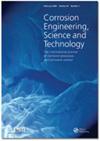Effect of pH on corrosion behaviour of CoCrNi MEA imposed by alternating current in Na2CO3/NaHCO3 solution
IF 1.5
4区 材料科学
Q4 MATERIALS SCIENCE, MULTIDISCIPLINARY
Corrosion Engineering, Science and Technology
Pub Date : 2023-08-23
DOI:10.1080/1478422X.2023.2247883
引用次数: 0
Abstract
ABSTRACT The corrosion behaviour and mechanism of CoCrNi medium-entropy alloy (MEA) imposed by alternating current (AC) in HCO3 −/CO3 2− solution with various pH were systematically investigated via a series of corrosion tests. The results showed that with the augment of pH value, the polarisation resistance of the MEA decreased significantly, Ep shifted negatively, and ipI value increased, as well as corrosion rate was enhanced, revealing that the corrosion resistance was weakened. As solution pH increased, the formation of secondary passivation zone became easier, which may be attributed to the reaction conversion process of Cr(III) to Cr(VI) species. Moreover, the increase in pH led to an increase in defect density and a thinning of passivation film, facilitating the corrosion of the MEA. AC interference accelerated the ion exchange process and promoted the formation possibility of stable pitting. Higher iAC and pH inhibited the repassivation of metastable pitting, and increased the pitting susceptibility. Highlights The effect of pH on the corrosion behaviour of CoCrNi MEA with imposed AC was clarified. High pH and iAC accelerated the nucleation and growth of metastable pits. With increased pH and iAC, the stability and protective ability of passive film were weakened. The secondary passivation of the MEA was mainly due to the conversion of Cr(III) to Cr(VI) species. GRAPHICAL ABSTRACTpH对CoCrNi MEA在Na2CO3/NaHCO3溶液中交流腐蚀行为的影响
通过一系列腐蚀试验,系统地研究了交流(AC)对CoCrNi中熵合金(MEA)在不同pH的HCO3−/CO3−溶液中的腐蚀行为和机理。结果表明,随着pH值的增加,MEA的极化电阻显著降低,Ep负移,ipI值增加,腐蚀速率提高,表明MEA的耐腐蚀性减弱。随着溶液pH的增加,二次钝化区的形成变得更容易,这可能归因于Cr(III)向Cr(VI)物种的反应转化过程。此外,pH的增加导致缺陷密度的增加和钝化膜的变薄,促进了MEA的腐蚀。交流干扰加速了离子交换过程,促进了稳定点蚀的形成。较高的iAC和pH抑制了亚稳态点蚀的再钝化,并增加了点蚀敏感性。重点阐明了pH对CoCrNi MEA在外加AC下腐蚀行为的影响。高pH和iAC加速了亚稳凹坑的形核和生长。随着pH和iAC的增加,钝化膜的稳定性和保护能力减弱。MEA的二次钝化主要是由于Cr(III)向Cr(VI)物种的转化。图形摘要
本文章由计算机程序翻译,如有差异,请以英文原文为准。
求助全文
约1分钟内获得全文
求助全文
来源期刊

Corrosion Engineering, Science and Technology
工程技术-材料科学:综合
CiteScore
3.20
自引率
5.60%
发文量
58
审稿时长
3.4 months
期刊介绍:
Corrosion Engineering, Science and Technology provides broad international coverage of research and practice in corrosion processes and corrosion control. Peer-reviewed contributions address all aspects of corrosion engineering and corrosion science; there is strong emphasis on effective design and materials selection to combat corrosion and the journal carries failure case studies to further knowledge in these areas.
 求助内容:
求助内容: 应助结果提醒方式:
应助结果提醒方式:


